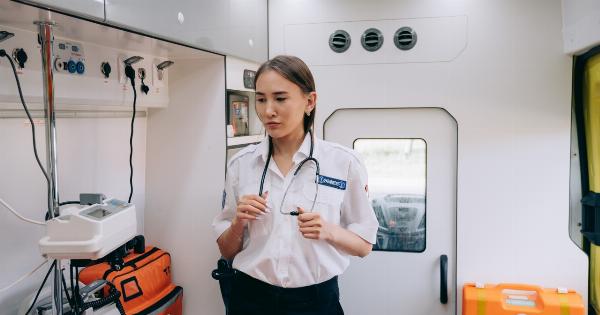Sexual activity is a natural and healthy part of adult life. However, like any physical activity, it comes with certain risks.
While most people are aware of the potential risks to their physical health during sex, such as sexually transmitted infections or physical injuries, there is another aspect that often goes overlooked – the potential risks to vision.
The Eye-Opening Reality
When engaging in sexual activity, people rarely consider their eyes as vulnerable body parts. However, there are several ways in which sexual activity can pose risks to vision.
From accidental eye injuries to sexually transmitted infections affecting the eyes, it is important to be aware of these potential blind spots.
1. Accidental Eye Injuries
During moments of passion, it is common for couples to get lost in the moment and lose track of their surroundings. Unfortunately, this can sometimes lead to accidental eye injuries.
A flailing hand or elbow can unintentionally strike the eye, causing pain, redness, or even more severe damage. It is crucial to be mindful of one’s surroundings and to avoid sudden, reckless movements during sexual activity.
2. Contact Lens Complications
Many individuals rely on contact lenses for improved vision on a daily basis. However, wearing contact lenses during sexual activity can pose risks.
Intense physical movements can cause the lenses to dislodge from the eye or become trapped under the eyelid. This can lead to discomfort, corneal abrasions, or more serious issues if not addressed promptly. It is recommended to remove contact lenses prior to engaging in sexual activity to avoid any potential complications.
3. Allergic Reactions
Sexual activities often involve the use of various lubricants, oils, or massage creams. While these products are generally safe for use, some individuals may have allergic reactions to certain ingredients.
If one is allergic to an ingredient present in these products and it comes into contact with the eyes, it can cause redness, itching, swelling, or even more severe symptoms. It is important to carefully read ingredient labels and select products that are known to be safe for personal use.
4. Sexually Transmitted Infections (STIs)
Sexually transmitted infections not only pose risks to reproductive health but can also affect vision. Some STIs, such as chlamydia, gonorrhea, and herpes, can cause eye infections if proper precautions are not taken.
Transmission can occur through direct contact with infected genital fluids or by touching infected genital areas and then touching the eyes. It is important to practice safe sex, including the use of condoms and regular STI testing, to protect both sexual and visual health.
5. Conjunctivitis
Conjunctivitis, commonly known as pink eye, is an inflammation of the conjunctiva – the thin, clear tissue that covers the white part of the eye and lines the inside of the eyelids.
While conjunctivitis is often caused by viral or bacterial infections, it can also be transmitted through contact with genital fluids. Engaging in sexual activity while a partner has conjunctivitis increases the risk of transmitting the infection to the other partner’s eyes.
It is crucial to practice good hygiene and avoid sexual contact during an active conjunctivitis infection.
6. Eyestrain and Fatigue
Sexual activity can often be physically demanding, requiring various positions and movements. These physical demands can lead to eyestrain and fatigue, especially if the activity takes place in low-light conditions.
Straining to see or focus on specific body parts or movements can cause temporary visual discomfort or even headaches. It is important to ensure proper lighting and take breaks if necessary to prevent eye strain during sexual activity.
7. Impact on Blood Pressure and Eye Health
Engaging in sexual activity can temporarily increase blood pressure due to physical exertion and cardiovascular activity.
Although the increase in blood pressure is usually not significant for most healthy individuals, those with preexisting eye conditions such as glaucoma or ocular hypertension should be cautious. Sudden increases in blood pressure can impact eye health and potentially exacerbate these conditions. It is advisable for individuals with ocular conditions to consult with their healthcare provider before engaging in vigorous sexual activity.
8. Vision Changes and Migraines
For some individuals, sexual activity might trigger migraines or vision changes known as aura. These aura symptoms can include visual disturbances such as flashing lights, blind spots, or temporary vision loss.
Migraines can be highly debilitating and can negatively affect the sexual experience. If migraines or aura symptoms are consistently triggered by sexual activity, it is essential to consult with a healthcare professional for proper diagnosis and management.
9. Eyedrops and Medications
Some individuals rely on various eyedrops or medications for the management of eye conditions such as dry eyes, glaucoma, or allergies. During sexual activity, it is important to be mindful of these eye-care regimens.
Lubricants or oils used during sexual activity might interact with eyedrops or cause temporary discomfort. It is recommended to plan sexual activity around prescribed eye-care routines to avoid any potential conflicts or adverse reactions.
10. Psychological Impact on Visual Perception
Although not a direct physical risk to vision, sexual activity can sometimes have a psychological impact on visual perception. Some individuals may experience anxiety or performance-related stress during sexual encounters.
These emotional states can potentially affect visual perception, making it more difficult to focus or maintain arousal. It is important to address any underlying psychological factors that might impact the overall sexual experience and seek appropriate support if needed.
Conclusion
While sexual activity is generally safe and enjoyable, it is crucial to be aware of the potential risks to vision.
From accidental injuries to STIs and allergic reactions, there are several factors that can put visual health at risk during intimate moments. By being mindful of these potential blind spots and taking necessary precautions, individuals can prioritize both their sexual and visual well-being.






























